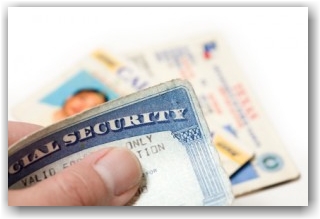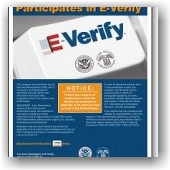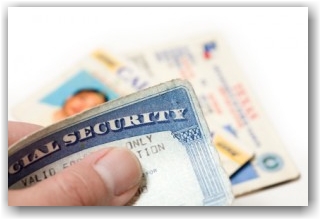Posts Tagged ‘ICE’
Monday, November 14th, 2016

On Nov. 14, 2016 USCIS released a revised version of Form I-9, Employment Eligibility Verification. Employers may continue using Form I-9 with a revision date of 03/08/2013N through Jan. 21, 2017. By Jan. 22, 2017, employers must use the revised form.
Employers should continue to follow existing storage and retention rules for all of their previously completed Forms I-9. Refer here for more information.
Remember to login to our webinar on Wednesday Nov. 16th, 3pm EST/12pm PST for training on the new I-9 form: http://www.immigrationcompliancegroup.com/webinars2016/ and save the date for the E-Verify webinar as well on December 15, 2016.
Tags: Employer Compliance, Employment Eligibility Verification, form I-9, I-9/E-Verify News, ICE, Immigation News, Legal Workforce, New I-9 Form, USCIS
Posted in Employer Compliance, Federal Contractors, I-9/E-Verify News, ICE, Immigration News, USCIS | Comments Off on BREAKING NEWS —————-NEW I-9 FORM RELEASED 11/14/2016
Friday, July 8th, 2016

This rule implements as an inflation adjustment fines for employing unauthorized workers for Form I-9 paperwork violations, and for immigration-related discrimination. These new fines increase the penalties from 35% to 96% depending on the nature and severity of the violation.
We encourage you to review your policies, procedures and your Form I-9 inventory. Remember, the key to defending any employment related investigation is to evidence that there is and has been a consistent pattern of responsible, good faith effort on the part of the employer in establishing a compliant workforce.
Refer here for the details.
Tags: DOJ, I-9 AUDIT, I-9 Compliance, I-9 Penalties, I-9/E-Verify, ICE, Immigration compliance, Legal Workforce, OSC, USCIS
Posted in DOJ, I-9/E-Verify News, ICE, OSC, USCIS | Comments Off on DOJ issues interim final rule increasing fines 35-96% for employing unauthorized workers
Thursday, April 14th, 2016

The OSC publishes responses to TAL Letters (Technical Assistance Letters) that they receive from attorneys, employers and other stakeholders. USCIS identifies this circumstance in the I-9 Employer Handbook as an employee who comes forward and indicates that their identity is now different than previously represented (Hmm…) and now wants to “regularize” their employment record. Or, what do you do if you become aware, for instance, that a social security number associated with a particular employee was not legally assigned?
Discussion starts on page 2.
OSC’s TAL implies that if an employer has not consistently-followed a policy of terminating individuals for providing false information during the hiring process, it couldn’t use that policy to justify a termination in this particular scenario. Even if the employer did consistently terminate individuals who were dishonest during the hiring process, OSC implied that this was not necessarily a slam dunk argument either. It is important to note that OSC did not commit itself by concluding that such a termination under the circumstances would not constitute discrimination or be deemed to be a valid legitimate non-discriminatory reason for termination. It simply stated it would depend on the facts and circumstances. Before you go down this road, remember –the USCIS Handbook for Employers provides that “Where an employee has worked for you using a false identity but is currently work authorized, the I-9 rules do not require termination of employment.”
There’s also guidance regarding this for DACA employees that you might wish to review. For more on I-9 compliance please refer to our Employer Resource Center
Tags: E-Verify, I-9 Compliance, I-9 Form, I-9/E-Verify News, ICE, Legal Workforce, Social Security, USCIS
Posted in DACA | DAPA, Department Of Labor (DOL), Employer Compliance, I-9/E-Verify News, ICE, OSC, Social Security | Comments Off on Employee Notifies that I-9 Documents Previously Submitted were not Genuine: What’s an Employer to do?
Wednesday, December 16th, 2015

The Department of Justice’s Office of Special Counsel (OSC) and the U.S. Immigration and Customs Enforcement (ICE) have issued a six-page joint Guidance for Employers Conducting Internal Form I-9 Audits that can be viewed here: http://www.justice.gov/crt/file/798276/download
This guidance is a result of a six-month intra-agency initiative to foster greater cooperation across government agencies in the I-9 audit space. The group overseeing this initiative, entitled the Interagency Working Group for the Consistent Enforcement of Federal Labor, Employment and Immigration Laws, is tasked with improving the effectiveness of investigations by ICE and the OSC.
For more
Tags: Department Of Homeland Security (DHS), Employer Compliance, Employment Eligibility Verification, I-9 Audits, I-9 Form, I-9/E-Verify News, ICE, Immigration compliance, Legal Workforce, OSC, Self-Audits
Posted in Uncategorized | Comments Off on OSC & ICE Publish Guidance to Employers on Internal I-9 Audits
Sunday, September 20th, 2015

Plain and simple, failing to comply with IRCA’s I-9 rules have, and are continuing at a rapid rate, to result in significant fines, loss of access to government contracts, an onslaught of negative publicity, business closure, criminal penalties and even imprisonment. Here are a few examples of recently settled cases in August 2015:
1) Creating discriminatory barriers for immigrants who have permission to work in the United States, $165 civil penalty with $50K in back pay:
http://www.justice.gov/opa/pr/justice-department-settles-discrimination-claim-against-louisiana-crane-construction
2) Requiring non-U.S. citizens, but not similarly-situated U.S. citizens, to present specific documentary proof of their immigration status to verify their employment eligibility, $200K civil penalty: http://www.justice.gov/opa/pr/justice-department-settles-immigration-related-discrimination-claim-against-nebraska-based
3) City of Eugene, OR improperly restricted law enforcement positions to U.S. citizens at the time of hire, even though no law, regulation, executive order or government contract authorized such a restriction. must pay a civil penalty, train its employees about the anti-discrimination provision of the INA and be subject to monitoring by the Justice Department for a period of three years!
http://www.justice.gov/opa/pr/justice-department-settles-citizenship-discrimination-claim-against-city-eugene-oregon
:::::::::::::::::::::
Immigration Compliance Group provides US inbound immigration services to individuals and employers throughout the USA and abroad. We specialize in business immigration and have a depth of experience in the IT, healthcare, arts, entertainment and sports industries, amongst others. Our services include complex business visas for investors, multinational managers, skilled professionals, outstanding individuals of high achievement (O-1, P visas, EB-1 and EB-2 Exceptional Ability cases) and PERM Labor Certification. We additionally provide employer compliance consulting services on proper I-9 (Employment Eligibility Verification) management, auditing, training, and work with our clients to develop a culture of immigration compliance. Our door is open for new clients — we extend a 20% discount on the first case with our firm. Contact us at info@immigationcompliancegroup.com or call 562 612.3996.
Tags: DOJ, Employer Compliance, Employoment Eligibility Verification, I-9 Audits, I-9 Form, I-9 Penalties, I-9/E-Verify News, ICE, Immigration News, Legal Workforce, OSC, Social Security Card, USCIS
Posted in DOJ, Employer Compliance, I-9/E-Verify News, ICE, Immigration News, OSC | Comments Off on Recent DOJ Worksite Enforcement Settlements that Shed Light on Form I-9 Employer Compliance
Monday, August 24th, 2015
The new rule provides SSA and the public with different options for verifying an applicant’s identity and other eligibility factors, noting that it will continue to require the same evidence to establish citizenship, age and identity. The new rule will also remove the requirement that individuals seeking a replacement SSN card file an SS-5 form, allowing them instead to complete a “prescribed application,” which the agency said would simply be the application form — whether paper, online or another efficient, user friendly method. Additionally, the SSA will release, through a gradual, state-by-state rollout, an online application that will permit adult U.S. citizens who are not reporting any changes to their record to apply for replacement SSN cards electronically after registering through the “my Social Security” portal.
How will this change procedures for processing the I-9 Employment Eligibility Verification Form? The article states that employers are likely to find more rapid turnaround should employees lack a lost or misplaced social security card requiring reissuance. USCIS Form I-9 permits employers to initiate employment, in most instances, if hired employees can verify within three (3) days employment eligibility through the documentary requirements of USCIS Form I-9, including presentation of a valid social security card under “List C” of Form I-9.
::::::::
Immigration Compliance Group provides US inbound visa services to individuals and employers throughout the USA and abroad. We specialize in business immigration and have a depth of experience in the IT, healthcare, arts, entertainment and sports industries, amongst others. Our services include complex business visas for investors, multinational managers, skilled professionals, outstanding individuals of high achievement and PERM Labor Certification. We additionally provide employer compliance consulting services on proper I-9 (Employment Eligibility Verification) management, auditing, training, and work with our clients to develop a culture of immigration compliance.
Tags: Employer Compliance, Employment Verification, I-9 AUDIT, I-9 Form, I-9/E-Verify News, ICE, Legal Workforce, Social Security Card, SSA, USCIS
Posted in DACA | DAPA, Employer Compliance, I-9/E-Verify News, Social Security, USCIS | Comments Off on New Social Security Card Process to Commence Sept 9, 2015
Friday, July 17th, 2015

USCIS released details of proposed new changes to the E-Verify program on June 8, 2015 that were published this week. The notice, found here, proposes several changes to E-Verify and seeks public comments until August 7, 2015 and links to new Q&A. These changes will affect all employer users, including Federal Acquisition Regulation (FAR) contractors.
The three critical changes entail:
1) Requirement that employers re-verify the continuing work authorization of employees within three “Employer” days of the expiration of the employee’s “last” grant of work authorization.
a) This requirement tracks the current continuing duty of employers to re-verify expiring work authorization of employees in Section 3 of the I-9 form or, in the alternative, to complete a new I-9.
b) This differs from the I-9 process in that the E-Verify time frame for re-verification of the employment authorization is three days after its expiration, whereby the I-9 regulations state that an employer re-verify the expiring work authorization of an employee on or before the day it expires. In E-Verify, the proposed process cannot be started until after the expiration of the employment authorization.
c) The re-verification requirement extends to employees hired before an employer began participating in the E-Verify program. Thus, the proposed change would require that employers re-verify an employee’s expiring work authorization regardless of whether they have previously created an E-Verify case for that employee or not. This again differs from the current E-Verify program rules that explicitly prohibit an employer verifying the work authorization of employees hired before the employer began participating in the program (with the exception of FAR E-Verify employers).
2) Requirement that employers print the re-verification confirmation page and retain it along with an employee’s I-9 records or record the E-Verify re-verification case number on the employee’s I-9 Form.
3) Provides a process for employees to seek review of E-Verify Final-Nonconfirmations.
::::::::
Immigration Compliance Group provides US inbound visa services to individuals and employers throughout the USA and abroad. We specialize in business immigration and have a depth of experience in the IT, healthcare, arts, entertainment and sports industries, amongst others. Our services include complex business visas for investors, multinational managers, skilled professionals, outstanding individuals of high achievement and PERM Labor Certification. We additionally provide employer compliance consulting services on proper I-9 (Employment Eligibility Verification) management, auditing, training, and work with our clients to develop a culture of immigration compliance.
Tags: Agriculture, E-Verify, Employer Compliance, FAR E-Verify, Federal Contractors, I-9 Compliance, I-9 Form, I-9/E-Verify News, ICE, Immigration News, Legal Workforce, OSC, Seasonal Workers, USCIS
Posted in Agriculture, Employer Compliance, Federal Contractors, I-9/E-Verify News, ICE, Immigration News, OSC, USCIS | Comments Off on E-Verify Announces Major Proposed Changes
Saturday, June 20th, 2015
 Since early 2015, qualified California residents have been able to apply for and receive a driver’s license issued by the Department of Motor Vehicles without proving that their presence in the United States is authorized under federal law. All employers must accept the AB 60 driver’s license as a Form I-9 List B Identity document if the license reasonably appears to be genuine and to relate to the individual. As with all permissible List B driver’s licenses, the AB 60 driver’s license must contain either a photograph or list the individual’s name, date of birth, gender, height, eye color, and address. The AB 60 driver’s license only documents the employee’s identity; California employers must still examine a List C document that establishes employment authorization, such as a Social Security card or birth certificate.
Since early 2015, qualified California residents have been able to apply for and receive a driver’s license issued by the Department of Motor Vehicles without proving that their presence in the United States is authorized under federal law. All employers must accept the AB 60 driver’s license as a Form I-9 List B Identity document if the license reasonably appears to be genuine and to relate to the individual. As with all permissible List B driver’s licenses, the AB 60 driver’s license must contain either a photograph or list the individual’s name, date of birth, gender, height, eye color, and address. The AB 60 driver’s license only documents the employee’s identity; California employers must still examine a List C document that establishes employment authorization, such as a Social Security card or birth certificate.
View the Example of the AB-CA Driver’s License annotated with “Federal Benefits Apply”.
Tags: CA AB-60 Driver's License, DACA, Department Of Homeland Security (DHS), Employer Compliance, EMPLOYMENT ELIGIBILITY, I-9 Form, I-9/E-Verify News, ICE, Immigration News, Legal Workforce, OSC, Social Security, USCIS
Posted in DACA | DAPA, Employer Compliance, I-9/E-Verify News, ICE, Immigration Legislation, Immigration News, OSC, Social Security, USCIS | Comments Off on California New AB 60 Driver’s License: Is it Good for Employment Eligibility?
Sunday, December 7th, 2014

On November 20, 2014, President Obama announced efforts to retool critical aspects of the immigration system—how we enforce immigration laws, how we process immigration benefits, how we encourage further business innovation, and how we welcome immigrants to this nation.
Following the address, executive agencies made available intra-agency memoranda and fact sheets detailing specific actions that have already been taken, or will be taken in the future in ten areas within the confines of the law. These actions generally involve border security, the current unlawfully present population, or future legal immigration.
Below we link to Fact Sheets that address the details that we are aware of at this time of the 10 Executive Action Initiatives with links to the memoranda. Additional guidance will be forthcoming.
The expansion of the DACA program that has now removed the age restriction and increases employment authorization from 2 year to 3-year increments, is expected to go into effect on or about February 20, 2015. The implementation of DAPA, the Deferred Action for Parental Accountability, that allows parents of US citizens and lawful permanent residents who have been present in the country since January 1, 2010 to request deferred action and employment authorization, is expected to roll out approximately mid-May 2015.
Resources:
http://www.uscis.gov/immigrationaction
http://www.dhs.gov/immigration-action
http://www.immigrationpolicy.org/special-reports/guide-immigration-accountability-executive-action
Should you have questions at this time or would like to retain our office to assist you or your employees with their immigration matters, please contact us at info@immigrationcompliancegroup.com or call 562 612.3996.
Tags: Business Innovation, DACA, DAPA, Department Of Homeland Security (DHS), Executive Action, H-1B, H-4, I-9 Form, ICE, Immigration News, Immigration Reform, Investor Visas, Undocumented Workers, USCIS
Posted in Comprehensive Immigration Reform, Congress, DACA | DAPA, Department Of Homeland Security (DHS), Employer Compliance, H-1B Visas, I-9/E-Verify News, ICE, Immigration News | Comments Off on Executive Actions on Immigration
Tuesday, October 7th, 2014

IMPORTANT INFORMATION
As of January 1, 2015, E-Verify will begin disposing of E-Verify records that are over 10 years old. In order to retain case information, E-Verify employers may download and save the new “Historic Records Report.” If you want a record of your cases that are more than 10 years old, you must download the new Historic Records Report before December 31, 2014. The report will include all transaction records for cases more than 10 years old. The report is only available until December 31, 2014.
NOTE – this Report will ONLY BE AVAILABLE from October 1, through December 31, 2014. The Fact Sheet provides more information as to how to proceed to download applicable E-Verify records.
If you were not using E-Verify on or before December 31, 2004, you do not need to download the report. There will be no records to report. Note that E-Verify will continue this practice on an annual basis.
:::::::::::::::::::::::::::::::::::::::::::::
USCIS Now Offering I-9 Webinars On-Demand
On September 25, 2014, USCIS published the first Form I-9 Webinar On – Demand. Now you can watch the free Form I-9 webinar at any time.
Choose the chapters of your choice or watch the entire 22 minute video in one sitting. You will see how to complete Sections 1, 2 and 3, best practices
and much more. It’s a great training tool. Visit I-9 Central to learn more and view other videos in the multi-media section.
 Form I-9 Webinar on Demand | USCIS uscis.gov
Form I-9 Webinar on Demand | USCIS uscis.gov
Tags: E-Verify, E-Verify Records Retention, Employer Compliance Policy, form I-9, I-9 On-Demand Webinars, I-9/E-Verify News, ICE, Immigration News, OSC, USCIS
Posted in Employer Compliance, I-9/E-Verify News, ICE, Immigration News, OSC, USCIS | Comments Off on E-Verify Records Retention and Disposal | I-9 Webinars On-Demand










